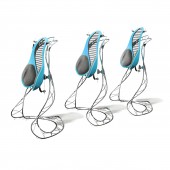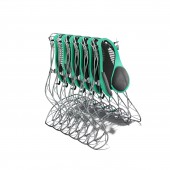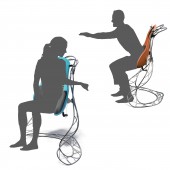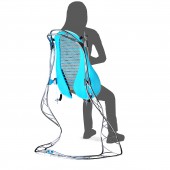
| THE AWARD |
| CATEGORIES |
| REGISTRATION |
| SUBMIT YOUR WORK |
| ENTRY INSTRUCTIONS |
| TERMS & CONDITIONS |
| PUBLICATIONS |
| DATES & FEES |
| METHODOLOGY |
| CONTACT |
| WINNERS |
| PRESS ROOM |
| GET INVOLVED |
| DESIGN PRIZE |
| DESIGN STORE |
| THE AWARD | JURY | CATEGORIES | REGISTRATION | PRESS | WINNERS | PUBLICATIONS | ENTRY INSTRUCTIONS |
Alcyone Standing Chair by Tetsuo Shibata |
Home > Winners > Design #100970 >Interview |
 |
|
FS: What is the main principle, idea and inspiration behind your design?
TS: After having had some health issues from sitting and working long hours at the office for many years, I wanted to design a product that would help me stand and work in an office while keeping my other body parts such as legs, hips, glute and upper body engaged at the same time. That health incidence in spite of being fairly active after hours and on weekends made me realize the importance of making a fundamental change to the way I work and exercise in order to prevent further damage to my health. And this started with evaluating the way I worked in terms of body anatomy and focusing on three things; maintaining a good posture throughout the day, keep moving as much as possible while working and to take a break often to do a quick workout assisted by a product I could design myself. With the backrest attached to the seat which follows the shape of natural arch of spine, keeping a good posture becomes easier as it prevents slumping forward and making the seat move vertically and sideways would allow body parts to keep moving as well. In order to engage in a bit more vigorous movement, I wanted to use this product as a chair/ exercise equipment with which I could perform sit and stand movement while seated, do hip twisting sideways to stretch hip flexor muscles and do a backward stretch by raising both arms over the backrest. Anyone could perform all of these exercises quickly and discreetly while working in the office or at home.
FS: What are your future plans for this award winning design?
TS: My plan is to build a prototype whether through industries and manufactures interested in financing and fabricating the product or through local fabrication shops I can work with directly. Production of parts will have to be relegated to several different shops and plants specializing in production of specific components. After the prototype is built, my hope is to have it tested and evaluated by different groups of people for a few months to find out the strengths and weaknesses of the design, to improve it and to promote it through advertisement, exhibition and/ or social media.
FS: How long did it take you to design this particular concept?
TS: This was a completely self-initiated project which took approximately two and a half years working part time in my own studio, and can be split into first and second phases. The first was an investigational phase and involved doing series of sketches, building scale models and a full scale mock-up and getting feedbacks from my colleagues. This is the period when I produced perhaps the largest amount of sketches, models and photographs to document manual fabrication processes for future reference. The second phase was more specific and concentrated on the current design that took about a year to the time I nominated my design to this competition.
FS: Is your design being produced or used by another company, or do you plan to sell or lease the production rights or do you intent to produce your work yourself?
TS: This is an important point about this project. And it is that, at this point, I am not certain that this product will work, much less, whether or not to sell or lease the production rights. By entering this competition, the pursuit of “nuts and bolts” portion of this project was put on hold in favor of refining the visual images which by themselves will be very useful in refining or redesigning the mechanical parts of the project in tangible three dimensional form. As I mentioned before, I would like to put the product through consumer testing and based on users’ feedback, it will be improved and redesigned slightly before considering leasing the production rights. Then there is a question of applying for the patent which will need to be secured before sending it for production. This patent will be strictly for the seat’s height adjustment mechanism and not for the overall design.
FS: Who is the target customer for his design?
TS: The target customers would be office workers with desk jobs because I was one of them in architect’s office. They typically sit in front of computer and work long hours without given a chance to move around much. My hope, especially in large offices, is to designate open space that includes high table/ counter that can accommodate standing chairs to be used for part of the day with computers spaced far enough apart on countertop. This standing chair is light weight and can easily be moved around to different parts of office by those wishing to work privately or for an impromptu meetings among coworkers. Other potential customers would be patients in a hospital or rehabilitation center recovering from leg injury, for example. This product could be used as an intervening device to get them to slowly regain strength and movement in lower body while also keeping upper body active by stretching, twisting and bending backwards. Artists, writers, security guards, IT specialists, announcers or anyone else whose job requires sitting down for most of the day could also be customers for this product.
FS: What sets this design apart from other similar or resembling concepts?
TS: What I found to be unconvincing in other so called “standing chair” on the market was the fact that however flexible or capable of tilting forward and sideways they may be, seats are positioned flat and horizontally in relation to the floor on which they stand. The seat on my standing chair is positioned at roughly 60 degrees – an angle that lets the user lean on it rather than sit on it as you would on a conventional chair. This leaning position also forces the user to distribute his weight to his legs. But my chair lets him distribute it to the third point of the body – arch of the spine, thanks to the backrest he can rest lower back, or thoracic curve, on. This not only prevents the entire weight being placed on the sitting bone – a source of much discomfort when sitting down for prolonged period of time but also keeps users from developing conditions such as peripheral edema and swayback. The backrest which is an integral part of the split seat is bent slightly backward in order to maintain good posture and to stimulate the back at all time to keep the spine flexible.
FS: How did you come up with the name for this design? What does it mean?
TS: I did some research on historical precedence for standing chair and found that in churches of the Middle Age Europe and even in historic churches and cathedrals of today, front edge of the folded up wooden seat is widened and supported by “misericord” or mercy chair which acts as a shelf to support the weight of a person leaning on it for long period of prayer. Often, these misericords had elaborate carvings of grotesque looking human, beasts, animals, birds, foxes, mermaids, etc. Since bird carvings were more pleasant to look at, I wanted to know the name of the bird most commonly depicted and found out it was Halcyon, a mythical kingfisher bird known to calm a rough sea. Kingfisher bird is also known as Alcyone in Greek myth and is a name of the brightest star in the Pleiades cluster, and I thought this was a perfect metaphor for my standing chair with the bright and colorful seat, or seven main stars, located centrally and supported by many points along the twisting metal frame that are countless smaller stars of the furthest galaxy.
FS: Which design tools did you use when you were working on this project?
TS: The project was divided into two major phases; analog phase and digital phase. Analog phase is subdivided into sketches, scale models and a full scale mock up. Digital phase is subdivided into 3d rendering on Rhinoceros and 3DS Max programs. For sketches, I used mechanical pencil with various lead grade, tracing paper, sketch book, light table for tracing old drawings, a small copier and a scanner for scanning my own sketches and photographs. For scale models, I used X Acto knives and a hotwire cutter to cut high density foam, hot glue gun to glue corrugated cardboards, spray gun to spray latex paint and a variety of hand tools to work with materials such as modeling clay, modeling aluminum wires, steel wire, 1/32” and 1/16” thick basswood sheets, aluminum pipes, small springs, epoxy glue, wire mesh and wooden dowels. For a full scale mock up which was built to test the comfort level of the seat at my own height, I used carving knives to carve the shape of the seat out of Styrofoam by hand and used table saw and band saw to cut 3/4” plywood to build a pedestal for the seat. For digital phase, my technical assistant and I used Rhinoceros, a 3d rendering computer program for initial low resolution rendering and 3ds Max program for high resolution and photo realistic rendering.
FS: What is the most unique aspect of your design?
TS: The seat’s height adjustment mechanism is probably the most unique aspect of this product and it was the most difficult part of the entire project. This was achieved through the use of steel cables attached to flexible prongs on both sides of the seat and they run through two conduits on each side that have PTFE flanged sleeve bearing inserted at both ends for minimal friction. These conduits or bent steel pipes are wrapped with Titanium metal support pieces that in turn are welded to vertical portion of the steel frame where the weight is transferred. The advantage of this system is that it uses push-pull forces generated by the curving cables and flexible prongs and suspends the seat. And regardless of the height position of the seat, it will not drop when the cables are unlocked and manual force is not applied to move it. Another unique aspect of this design is that it can be used as an exercise chair with which users can perform a simple sit-and-stand movement by holding the thin edge of the seat and propelling himself up and down using only his leg muscles. This chair can be transported and moved around easily by tilting it back slightly and pushing it forward with minimal force when castors are engaged. It can also be stacked by folding the flat portion of the steel base up and stored in closets in office, home or school.
FS: Who did you collaborate with for this design? Did you work with people with technical / specialized skills?
TS: During the analog phase, I worked by myself for the most part. The most meaningful collaboration during this phase was the studio critique when I invited a couple of my design colleagues from outside. Their main critique of the seat I made out of Styrofoam was that the backrest needed to be softer, not rounded and pointed, and be more flexible so that it presses against tightened back muscles more gently. Another suggestion was that the seat height needed to be adjustable not only for accommodating people of different height but also for using it as a regular chair that they could sit at their normal sitting height. I agreed and incorporated all of their suggestions into my final design. For digital phase, I collaborated with an architect friend of mine who was very well versed in 3d computer rendering. His knowledge of Rhinoceros 3d rendering program lent itself well for organic shape of my standing chair design. It is an excellent tool for rendering with accuracy and applying details and reflective quality. And since I had already built a scale model at 3”=1’-0” with moveable seat built into it, he could take an accurate measurement from the model for the twisting steel base and the seat at different heights - area that cannot easily be drawn with accuracy on Autocad program - and render them in such a manner as to be ergonomically and aesthetically pleasing. For the final push, I asked him to refine the image so that the glossy quality of the steel base, prongs and conduits, saturated color of the seat, softness of the seat cushion and flexible quality of the fabric mesh would be shown with high degree of accuracy using 3DS Max program.
FS: Is your design influenced by data or analytical research in any way? What kind of research did you conduct for making this design?
TS: One important goal in coming up with the shape of this chair was to simulate the natural form of the human body as much as possible - its curve, flexibility, durability, aerodynamics and adaptability, among other characteristics - and to use the chair's vertical and lateral movement as well as its performance to address some of the physical problems we all have while working at a desk, such as lower back pain, bad posture, peripheral edema, and forward slump. To help achieve and maintain this natural curve, the shape of the seat and backrest as a unit follow closely the natural arch of the spine - the foundation of a healthy body and mind. Much of my research, then, involved talking to physical therapists and chiropractors and reading numerous articles online about the ailments and ill health effects of sitting too much. The Washington Post's excellent Health & Science section was another valuable research source that advocated for a healthier lifestyle and talked a great deal about the peril of our immobile modern lifestyle and what we can do to correct it holistically. Earlier in the design process, I built a full scale mock-up of this chair by carving a seat out of Styrofoam and placing it on a pedestal base made out of plywood, then testing it on myself at home. The current design came about around this time after I built a scale model at 3"=1'-0" using high-density foam, clay, and soft aluminum modeling wire. As further research into materials and fabrication methods for this product, I read "materials For Inspirational Design", on both metals and plastics, by Chris Lefteri, and I visited local metal fabrication and auto mechanic's shop to gain understanding of the properties of the materials to be used for my project.
FS: How did you decide to submit your design to an international design competition?
TS: This standing chair design consists of two separate components; Tactile quality and visual appearance of the product which is Design and mechanical and engineering components of this product that allows the kinetic movement of the seat propelled by human power which may be called Invention. Although, it is the invention part that makes it functional and practical as a standing chair, it is ultimately the Design that has a potential to appeal to users’ senses and feelings that lead to familiarity and attachment to this product. Another reason had to do with potential end users and where they live and I thought if I could first appeal to group of people most inclined to use this product and let them extol the virtue of this product, or disapprove of it completely, where else to find them but in European countries where more health and environmentally conscious people live per capita than anywhere else in the world. So my decision to enter this particular design competition was a conscious one. And instead of exhibiting it in the galleries as a stand-alone precious object, I wanted to share it with global audience, designers and non-designers alike, through an international competition that had enormous outreach and publicity potential.
FS: Thank you for providing us with this opportunity to interview you.
A' Design Award and Competitions grants rights to press members and bloggers to use parts of this interview. This interview is provided as it is; DesignPRWire and A' Design Award and Competitions cannot be held responsible for the answers given by participating designers.
| SOCIAL |
| + Add to Likes / Favorites | Send to My Email | Comment | View Press-Release | Translations |





